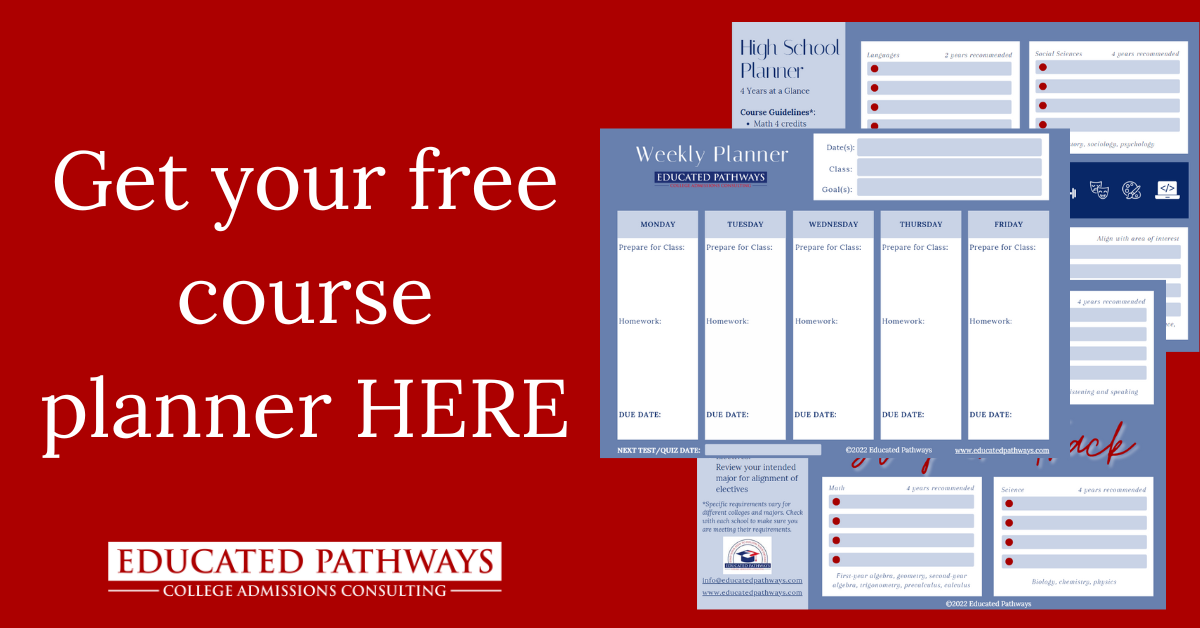High School Course Planning: A Step-By-Step Guide
Are you a high school student starting to plan out your courses for next year? Or maybe you are a parent of a high school student and you want to help them get started on the right track. Either way, this blog post is for you! In it, we will walk you through the step-by-step process of planning out your high school courses. Let's get started!
1. Start by reviewing your options
As you start to navigate the exciting journey of high school, make sure to locate your high school course curriculum guide. This will be your helpful companion as it outlines all of the courses available and allows you to explore pathways that match up with your college goals. Also, review your teachers’ recommendations. Just remember, your teachers can’t see your other course recommendations and they don’t know what your commitments are outside of high school. It’s up to you to use your best judgment when it comes to evaluating the level of rigor, aka challenge, you can handle.
2. Make a 4-year plan
Don’t just plan one year of coursework at a time. It is essential to look at the total coursework you intend to take over the course of your high school career. One of the things colleges look for is increasing rigor over the course of a transcript, so this will allow you to plan that out. It will also allow you to see if one year is particularly overloaded, and it will give you an opportunity to balance out the courses over several years, if possible. Lastly, it will establish the overall rigor of coursework that you will have at the time of graduation, which will help determine your academic profile for your college applications.
If your school doesn't provide a course planning guide. We have one for you. You can download it for free HERE.
3. Take 4 years of core curriculum
This is quite possibly the one area where students make the most honest mistakes. There is a difference between meeting graduation requirements and being competitive when you are applying to college. Many students can meet the graduation requirements in specific subject areas well before graduation and then neglect to take all core subjects throughout high school. That may be a mistake. Colleges generally do not like to see a gap in core subjects coming into college.
Additionally, not taking 4 years of math, science, English, and social studies when the majority of the applicants will be, could put you at a disadvantage and hurt your chances of admission. It is not a risk worth taking. Make sure you take each of the core subjects in your 4 years in high school.
4. Take 2 years of the SAME foreign language
The foreign language requirement is one that has some variation and also some confusion. Most colleges require students to take 2 years of the same foreign language in high school, and a few require more than that. Some colleges will allow that credit to come from middle school foreign language courses if they appear on the high school transcript, however, that is not the case with all schools. What constitutes a foreign language varies from state to state as well. Of course, all of the traditional languages qualify, but in some cases, American Sign Language or Computer Science may qualify.
5. Balance the amount and type of rigor in your schedule carefully
You have many options to choose from when it comes to high school courses. You can take on level, honors, AP, dual enrollment, and any combination. Take what makes sense for you. Colleges generally like to see students take the most challenging coursework available to them at their high school before going outside of their building for additional courses. However, there may be compelling reasons for a student to choose a dual enrollment course over an AP course. There also might be an argument for a student to stay in the AP course and NOT take the dual enrollment course that is available to them.
As you plan your high school journey, course selection can seem like a daunting task. By determining which courses meet your specific needs and goals, you can make an informed decision about which courses to take that will help you reach those goals. Reviewing all of the options available and making a four-year plan will not only give structure to your work but also ensure that you are taking the right classes for graduation requirements. Don’t forget about taking core classes and two years of the same foreign language for college admission. Finally, find the right balance between rigor and challenge in order to create an optimal course selection that is unique to you.





